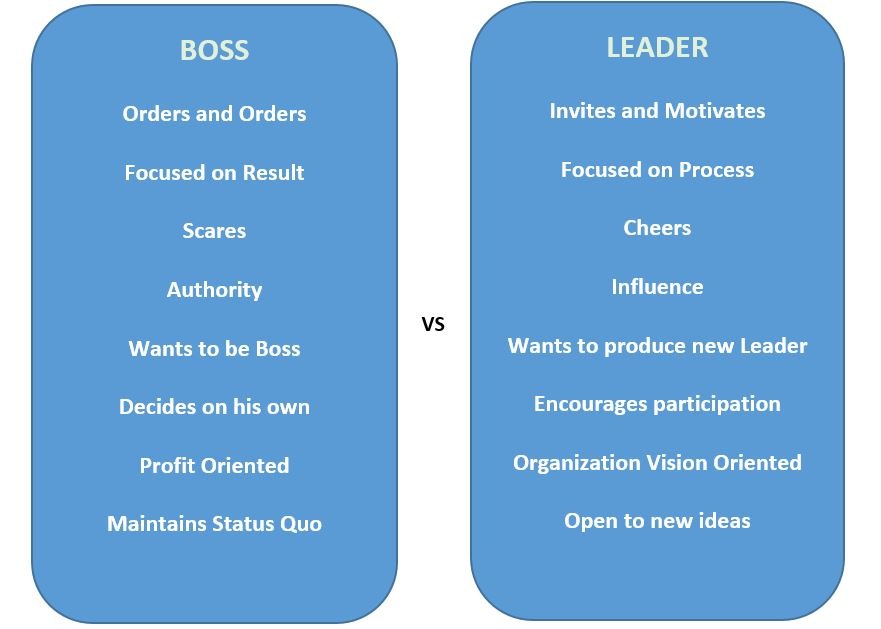The term “boss” is often used interchangeably with the term “leader.” However, these two terms have different meanings.
Boss is a word for people with hierarchical positions in the organization who have power over others and can give them orders. The boss controls their subordinates according to predetermined standards while they’re at work.
Leaders often appear in different places and can inspire people to act together. Leaders are not always related to their structural position, but they can affect team members and the organization.

8 Differences Between Leader and Boss
Boss orders and orders, the leader invites and motivates
The boss works by ordering and telling employees to do the work. He’s in the back, not involved in any tasks, only delegates them to other people, and then supervises these people.
Contrast that with a leader who works by inviting and motivating team members. He is involved in the work and leads the way to set an example for others.
Boss focused on results; a leader focused on the process
A boss is more concerned with the result, namely employee performance and productivity which numbers can measure. Defining a successful employee aims to achieve their work targets in daily, weekly or monthly periods.
Leaders focus on the long-term process of achieving team or group goals and define successful employees based on their quality of self-development. They’ll help you grow in a way that is best aligned with the organization’s vision.
Boss scares, leader cheers
The boss controls the team by creating fear, for example, with sanctions and rewards, so that subordinates remain submissive to their superiors. Boss wants to make sure everyone on the team obeys orders.
Leaders tend to encourage their team and value each employee’s contribution. He wants employees to have initiatives that align with group values in achieving common goals.
Boss relies on authority; the leader relies on influence
The boss relies on the authority of his position to give orders, divide tasks, and supervise employees. Employees obey him because he has power.
Leaders rely on their ability to influence others to do what they want them. Employees admire him for his strong personal character and the values he brings with him into the organization.
Boss wants to be boss; the leader wants to produce a new leader
Bosses are interested in maintaining their status and power. To do this, they try to stay in charge and regulate the people around them.
Leaders want to inspire team members and encourage them to become new leaders. Leaders see themselves as successful if they have produced more successful leaders from their teams.
Boss decides on his own; the leader encourages participation
The boss makes decisions of their own accord in many things related to work, then applies these considerations to all subordinates. Employees do not have autonomy and are only required to comply with what has been decided by superiors.
The leader encourages employees to participate and collaborate. Employees are given the trust, responsibility, and autonomy to make decisions for each other to practice their problem-solving skills.
Boss oriented to profit, leader oriented to the vision of the organization
The boss is oriented towards profits or company profits. Employee performance is measured using numerical parameters such as financial benefits to be assessed as successful.
The goal of a leader is to the company’s vision. For this goal to happen, leaders must focus on developing teamwork, innovation, and collaboration in their teams.
Boss maintains status quo; the leader is open to new ideas
A boss is more conservative and has control of maintaining the status quo. Employees only carry out routines that have been outlined in a standard work process.
Leaders are more open to new ideas that bring change for the better and help them achieve goals. It also challenges employees to be creative in finding solutions.
Also, read about the project manager guide.
Which one works best for you, whether you are a boss or a leader?
In today’s competitive marketplace, you need to produce extraordinary results.
Even though you may have had a leadership style that has worked, it’s essential to consider where you are and where you want to be.
To figure out if you’re a boss or a leader, ask yourself these questions:
- Do I make every effort to ensure that everyone’s voice is heard?
- Do I emphasize self-improvement and career advancement through books or further education?
- Do I assist employees in learning from their mistakes?
- Do I actively seek latent talent on my team?
- Do I assist others in reaching their full potential?
- Is it true that I listen more than I speak?
- Do I hold myself to the same standards to which I hold my team?
You would be a leader if you replied ‘Yes’ to any or all of these questions. If not, look over the areas where you replied ‘No’ and think about how you can improve.
As a leader in your organization, it is essential to build a great team that can support you. A successful team combines technical skills, soft skills, and values that align with your company’s goals.


